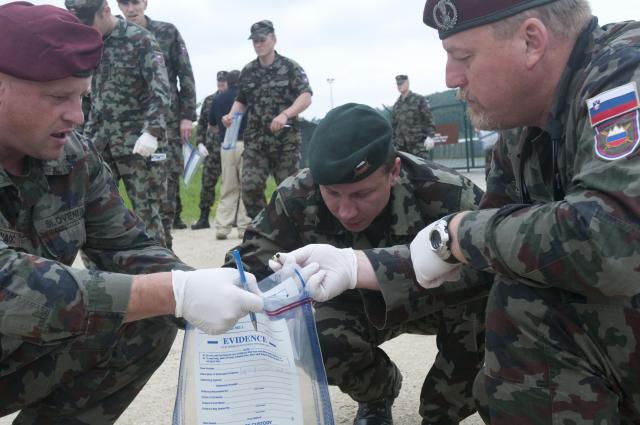Germany: On March 18, 2010, U.S. Secretary of Defense Robert M. Gates outlined a directive to the combatant commanders to tangibly support partnered nations to “increase the effectiveness of their forces to counter improvised explosive devices.”
The directive states; “we must now move forward with concrete actions to assist our coalition partners and enhance their C-IED (counter-improvised explosive device) capabilities in the areas of equipment, training and technical expertise.”
In response to this directive European Command, and subsequently U.S. Army in Europe tasked the Joint Multinational Training Command, or JMTC, in Grafenwoehr, Germany, to increase the capacity of C-IED training for our partner nations in Europe.
The JMTC has always worked with partner nations to conduct training during brigade rotations, and specifically on C-IED to ensure the success of the mission and to save soldiers lives; no matter what flag they are wearing.
One unique aspect of the JMTC’s U.S. and NATO training rotations is the participation of coalition forces, which enhance the training environment. Partnered nations act as Afghan Army replicators or additional units on the battlefield, such as Provincial Reconstruction Teams (PRTs) or company maneuver formations.
They in turn receive training on C-IED in a counter insurgency, commonly referred to as COIN, environment as part of a larger brigade force. Thirty percent of the forces that make up the International Security Assistance Force in Afghanistan are coalition forces, and of that 30 percent, more than 80 percent are from the U.S. European Command’s area of responsibility.
It’s a natural fit for JMTC to assist partners in C-IED training and capacity building, whether in Germany or at their home station.
At the JMTC, C-IED training focuses on collective training from patrol-size elements to brigade-and-battalion battle staffs. The JMTC teaches many courses to help partnered nations build capacity, as well as multinational C-IED cooperation.
The Defeat the Device Baseline Course, conducted at Hohenfels, focuses on senior noncommissioned officers and junior company-grade officers, providing them a baseline understanding of C-IEDs to facilitate the training of their own troops prior to deployment.
The Attack the Network Battle Staff Course, conducted at the host nation, focuses on battalion and brigade staffs and prepares them to operate in a C-IED or COIN, environment.
Train the Force Situational Training Exercise, or TtF STX, focuses on a battalion’s company and platoon patrols preparing formations for deployment, and enabling nations to build capacity in their country through C-IED training. The C-IED TtF STX is taught at Hohenfels and in the host nation.
The JMTC’s CIED Master Trainer course conducted at Grafenwoehr, builds on the Defeat- the-Device Course by providing partner nations Master Trainers to expand and build on their Train-the-Force and Attack-the-Network capability.
In 2010, JMTC trained more than 4,000 U.S. and multinational Soldiers as part of brigade rotations.
The JMTC implemented a multinational Defeat-the-Device Route Clearance Patrol course in November while also standing up the “Badger” C-IED Training team, which will be fully operational in spring 2011.
The multinational courses at JMTC are focused on two things: preparing soldiers for combat in a C-IED/COIN environment, and saving soldiers lives no matter what flag they wear. All courses are conducted in accordance with International Security Assistance Force and NATO standards.
The JMTC will continue to support our coalition partners and assist in building national capacity as part of the Security Forces Agreement outlined by Secretary Gates.











